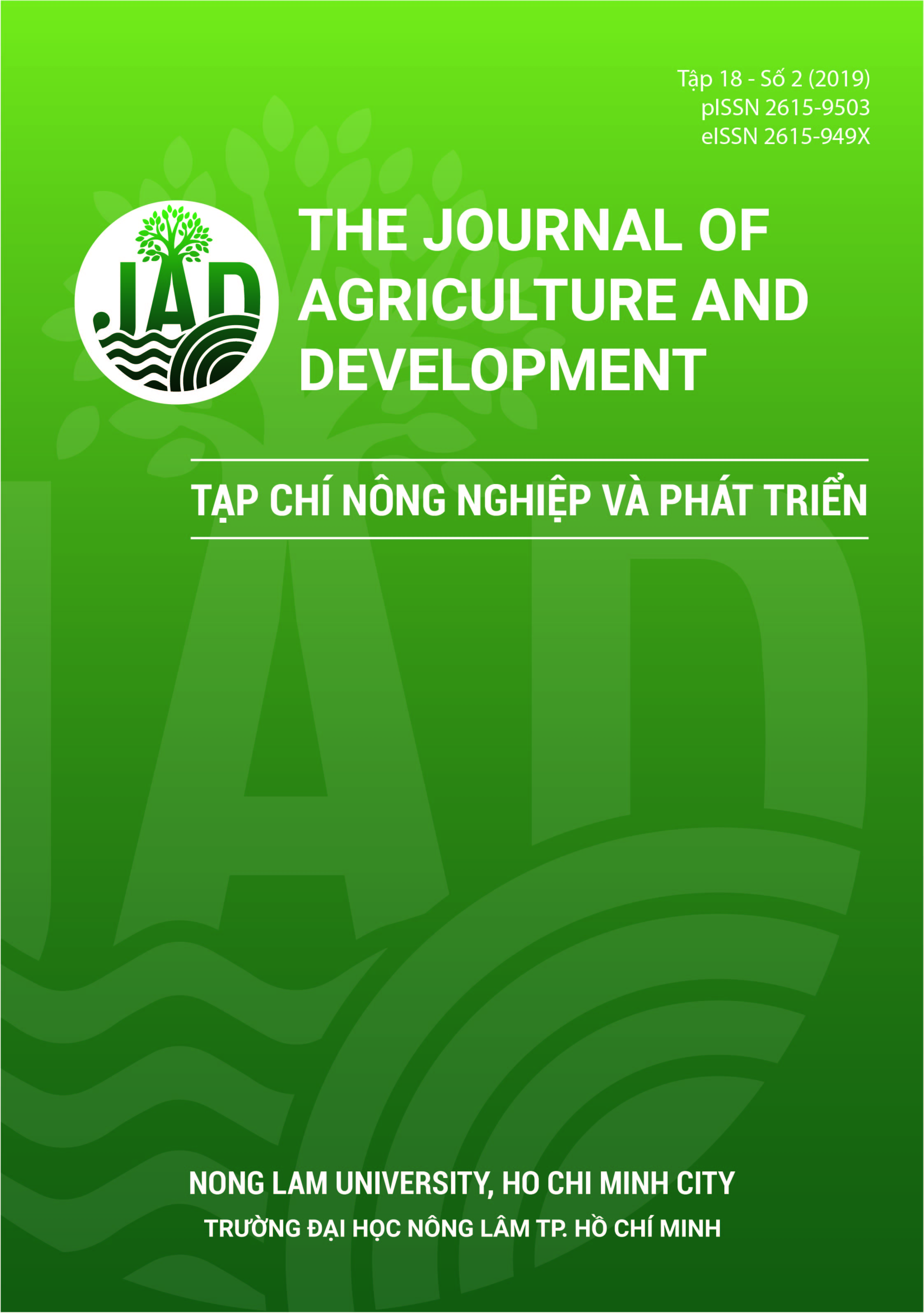Ảnh hưởng của vôi và mụn dừa đến sự hấp thu Cadimi trong cây đậu phộng (Arachis hypogaea L.) trồng trên đất phù sa không bồi tại An Phú – An Giang
Main Article Content
Tóm tắt
Ngày nay, ô nhiễm Cadimi (Cd) trong đất đã được cảnh báo rất nhiều huyện trong tỉnh An Giang. Nghiên cứu Ảnh hưởng của vôi và mụn dừa đến sự hấp thu Cadimi trong cây đậu phộng (Arachis hypogaea L.) trồng trên đất phù sa không bồi tại An Phú-An Giang đã được thực hiện với các mục tiêu: (i) đánh giá thực trạng hàm lượng Cd trong môi trường đất sử dụng trồng trọt tại huyện An Phú, tỉnh An Giang, (ii) ảnh hưởng của bón vôi và mụn dừa đến sự giảm hút thu Cd lên cây đậu phộng. Thí nghiệm đơn yếu tố được bố trí theo kiểu khối đầy đủ hoàn toàn ngẫu nhiên, 4 nghiệm thức và 4 lần lặp lại. Các nghiệm thức được xây dựng dựa vào lượng vôi và mụn dừa bón cho cây đậu phộng, cụ thể như sau: bón vôi (5 tấn/ha); bón mụn dừa (5 tấn/ha); bón kết hợp vôi (5 tấn/ha) với mụn dừa (5 tấn/ha); Đối chứng (không bón vôi, mụn dừa). Thí nghiệm được thực hiện ngoài đồng ruộng nằm trong đê bao. Kết quả nghiên cứu cho thấy tất cả các mẫu đất nơi thí nghiệm trồng đậu phộng đều nhiễm Cd cao từ 235 µg/kgđến 240 µg/kg. Nghiệm thức bón kết hợp vôi (5 tấn/ha) với mụn dừa (5 tấn/ha) có hàm lượng Cd trong hạt và trong thân của đậu phộng thấp hơn nghiệm thức không có bón vôi và mụn dừa lần lượt là 34% và 19%. Hàm lượng Cd trung bình trong thân là 81,0 μg/kg, hạt là 27 μg/kg ở nghiệm thức bón vôi kết hợp mụn dừa thấp nhất so với các nghiệm thức còn lại. Từ đó có thể kết luận việc bón vôi kết hợp với mụn dừa cho thấy hiệu quả giảm sự hấp thu Cd lên cây đậu phộng tốt nhất và thấp nhất là trồng không bón vôi và mụn dừa.
Article Details
Tài liệu tham khảo
Chen, H. M., Zheng, C. R., Tu, C., & Shen, Z. G. (2000). Chemical methods and phytoremediation of soil contaminated with heavy metals. Chemosphere 41(1-2), 229-234. https://doi.org/10.1016/S0045-6535(99)00415-4
De Matos, A. T., Fontes, M. P. F., da Costa, L. M., & Martinez, M. A. (2001). Mobility of heavy metals as related to soil chemical and mineralogical characteristics of Brazilian soils. Environmental Pollution 111(3), 429-435. https://doi.org/10.1016/S0269-7491(00)00088-9
Hasan, S. A., Hayat, S., Ali, B., & Ahmad, A. (2007). 28-homobrassinolide protectschickpea (Cicer arietinum) from cadmium toxicity by stimulatingantioxidant. Environmental Pollution 151(1), 60-66. https://doi.org/10.1016/j.envpol.2007.03.006
Mclaughlin M. J., Hamon R. E., Maier N. A., Correll R. L., Smart M. K., Grant C. D. (1998). In-situ immobilisation techniques to remediate cadmium-contaminated agricultural soils. In: Proceedings of the 6th International FZK/TNO Conference on Contaminated Soil (453-460). Edinburgh, UK.
MOH (Ministry of Health). (2011). Circular No. QCVN 8-2:2011/BYT dated on January 13, 2011. National technical regulation on the limits of heavy metals contamination in food. Ha Noi, Vietnam: MOH Office.
MONRE (Ministry of Natural Resources & Environment). (2015). Circular No. QCVN 03MT:2015/BTNMT dated on December 21, 2015. National technical regulation on the allowable limits of heavy metals in the soils. Ha Noi, Vietnam: MONRE Office.
Nguyen, C. V., & Ngo, H. N. (2015). Research on mitigating of rice, maize and mung beans uptake of cadmium in An Phu district, An Giang province. Journal of Agriculture and Rural Development 12, 72-77.
Nguyen, C. V., & Ngo, H. N. (2012). The demand of phosphate and the correlation with phosphate-cadimi in corn, rice and mungbean cultivated on slob at An Phu. Journal of Agriculture and Rural Development 1, 101-106.
Nguyen, O. H. (2003). Status of using phosphate fertilizer in agriculture and estimation of Cd contamination in the environment in MeKong Delta (Unpublished master’s thesis). The College of Agriculture, Can Tho University, Can Tho, Vietnam.
Nguyen, V. B., Tran, B. T. K., Nguyen, T. T. X., & Le, T. V. (2011). Short-term industrial plants-lecture notes (106-179). Can Tho, Vietnam: Can Tho University.
Nogawa, K. (1984). Cadmium in changing metal cycles and human health. In Nriagu, J. O. (Ed.). Changing metal cycles and human health (275-284). Berlin, Germany: Springer.
Sarma, M., Gautam, K. H., & Handique, A. K. (2006). Toxic heavy metal stress in paddy: Metal accumulation profile and development of a novel stress protein in seed. Indian Journal of Plant Physiology 11(3), 227-233.
Shukla, S. R., Pai, R. S., & Shendarkar, A. D. (2006). Adsorption of Ni(II), Zn(II) and Fe(II) on modified coir fibres. Separation and Purification Technology 47(3), 141-147. https://doi.org/10.1016/j.seppur.2005.06.014
Tan, W. N., Li, Z. A., Qiu, J., Zou, B., Li, N. Y., Zhuang, P., & Wang, G. (2011). Lime and phosphate could reduce cadmium uptake by five vegetables commonly grown in South China. Pedosphere 21(2), 223-229. https://doi.org/10.1016/S1002-0160(11)60121-5
Van Asshe, F., & Clijsters, H. (1990). Effects of metals on enzyme activity in plant. Plant, Cell and Environment 13(3), 195-206. https://doi.org/10.1111/j.1365-3040.1990.tb01304.x








